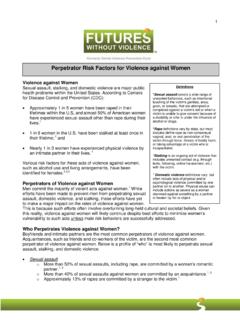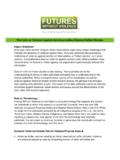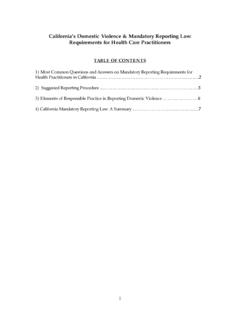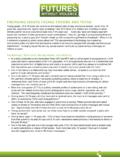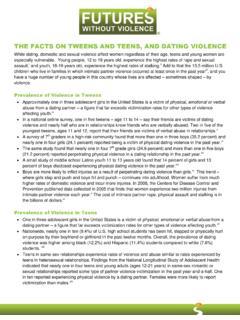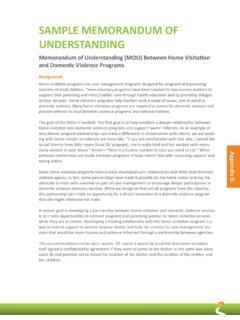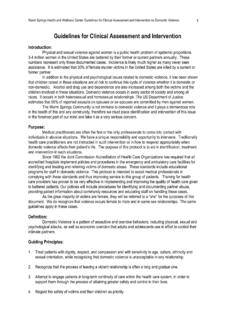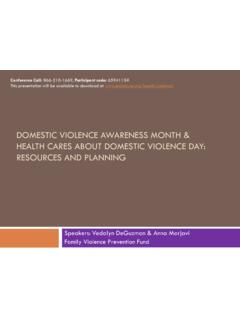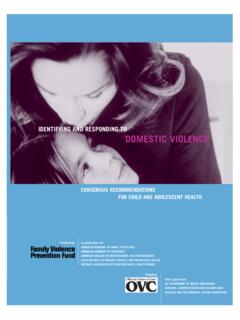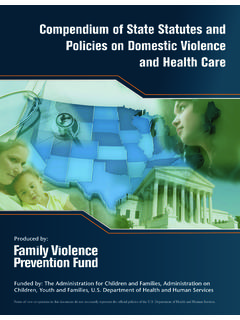Transcription of National Consensus Guidelines - …
1 ON IDENTIFYING ANDRESPONDING TODOMESTIC VIOLENCEVICTIMIZATIONIN HEALTH CARE SETTINGSN ationalConsensusGuidelinesProduced byTHE FAMILY VIOLENCE PREVENTION FUNDF unded byTHE CONRAD N. HILTON FOUNDATION AND THE DEPARTMENT OF HEALTH AND HUMAN SERVICES,ADMINISTRATION FOR CHILDREN AND FAMILIESF amily Violence Prevention FundFor more than two decades, the Family ViolencePrevention Fund (FVPF) has worked to endviolence against women and children around theworld. Instrumental in developing the landmarkViolence Against Women Act passed by Congressin 1994, the FVPF has continued to break newground by reaching new audiences including menand youth, promoting leadership withincommunities to ensure that violence preventionefforts become self-sustaining, and transformingthe way health care providers, police, judges,employers and others address FVPF is a National non-profit organizationcommitted to mobilizing concerned individuals,allied professionals, women s rights, civil rights,other social justice organizations and children'sgroups through public education/preventioncampaigns, public policy reform, model training,advocacy programs and copies of this publication may be purchased or by phone: (415) 252-8089 FAMILY VIOLENCE PREVENTION FUNDHEALTH STAFF.
2 Lisa James, MA, Debbie Lee, Anna Marjavi,Vibhuti Mehra, MA, Fran Navarro, Rebecca Whiteman, MAAny adaptation or reprinting of thispublication must be accompanied by thefollowing acknowledgement:PRODUCED BYThe Family Violence Prevention Fund383 Rhode Island Street, Suite 304 San Francisco, CA 94103-5133(415) 252-8900 TTY (800) 595-4889 First Printing: September, 2002 Updated: February, 2004If you would like more information aboutimproving the health care system s responseto domestic violence contact:The Family Violence Prevention Fund sNational Health Resource Center onDomestic : 1-800-595-4889 FUNDED BYThe Conrad N. Hilton Foundation and Department of Health and HumanServices, Office of Community Services,Administration for Children and FamiliesGraphic design by Liz ChalkleyFamily Violence Prevention FundNational Consensus Guidelines ON IDENTIFYING AND RESPONDING TO DOMESTIC VIOLENCE VICTIMIZATIONIN HEALTH CARE SETTINGSNATIONALGUIDELINESCONSENSUSS pecial Thanks to theNATIONAL ADVISORY COMMITTEE MEMBERSF amily Violence Prevention FundNational Advisory Committee MembersElaine Alpert, MD, MPHB oston University School of Public HealthMassachusettsJacquelyn C.
3 Campbell, PhD, RN, FAANJ ohns Hopkins UniversityMarylandLinda Chamberlain, PhD, MPHA laska Family Violence Prevention ProjectAlaskaAnne L. Ganley, PhDUniversity of WashingtonWashingtonLeigh Kimberg, MDMaxine Hall Health CenterCaliforniaMargaret M. McNamara, MDUniversity of California, San FranciscoCaliforniaTerri E. Pease, PhDServiceNetMassachusettsPatricia R. Salber, MDPhysicians for a Violence-free SocietyCaliforniaThe Family Violence Prevention Fund (FVPF) wishes to thank the National Advisory Committeemembers for the National Consensus Guidelines on Identifying and Responding to DomesticViolence Victimization for their time and rigorous attention to the development of these Consensus can be complicated and the expertise, experience and guidance of AdvisoryCommittee members were invaluable. These individuals include members from the advisorycommittee for the FVPF s original Preventing Domestic Violence: Clinical Guidelines on RoutineScreening as well as representatives from fourteen states participating in the FVPF's NationalHealth Care Standards Campaign on Domestic Violence.
4 Carole Warshaw, MDHospital Crisis Intervention ProjectIllinoisDeborah Zilmer, MDAmerican Academy of Orthopaedic SurgeonsIllinoisNational Advisory Committee Members from the National Health Care Standards Campaignon Domestic ViolenceALABAMA:Angie Boy Alabama Coalition Against Domestic ViolenceCALIFORNIA:Angela KaufmanCity of Los AngelesConnie Mitchell, MDCalifornia Medical Training Center,University of California, DavisFLORIDA:Sandi RobinsonDomestic and Sexual Violence ProgramDoris Campbell, PhDUniversity of South FloridaNEVADA:Shelly Baker, MSWS outhwest Medical Associates Eryn BranchNevada Network Against Domestic ViolenceNEW HAMPSHIRE:Deb Hastings MS, RN, CNORSt. Anselm College, ManchesterMargo Krasnoff, MDSection of General Internal MedicineJennifer Pierce-Weeks, RNNew Hampshire Coalition Against Domestic and Sexual ViolenceOHIO:Sandy HuntzingerOhio Coalition Against Domestic ViolencePENNSYLVANIA:Nancy DurborowPennsylvania Coalition Against Domestic ViolenceWASHINGTON :Kim Bullock, MDProvidence HospitalWEST VIRGINIA:Laurie ThompsenWest Virginia Coalition AgainstDomestic ViolenceWISCONSIN:Susan RamspacherWisconsin Coalition Against Domestic ViolenceIOWA:Binnie LeHewIowa Department of HealthKathy Dolan, RN, CENE mergency Nurse s AssociationILLINOIS:Lynda DautenhahnIllinois Department of Public HealthJohn Lumpkin, MD, MPHI llinois Department of Public HealthBarbara ShawIllinois Violence Prevention AuthorityMASSACHUSSETTS.
5 Paulani EnosNortheastern UniversityAnnie Lewis-O Connor, RNCS, MSN, MPHB oston UniversityCarlene PavlosViolence Prevention and Intervention UnitLiza Sirota, MSJLSJane Doe :Julie Beck, LMSWThe Bridge Program, Rose Brooks CenterCathy Blair, RN, LCSWAWARE, Barnes Jewish HospitalDr. Stephanie Ellison, MDTruman Medical Center WestAdvisory CommitteeFamily Violence Prevention FundFamily Violence Prevention FundFamily Violence Prevention FundPART IINTRODUCTION, DEFINITIONS AND RATIONALEPART IIGUIDELINES FOR RESPONDING TO INTIMATE PARTNER VIOLENCE VICTIMIZATION INHEALTH SETTINGSPART IIIQUALITY IMPROVEMENT GOALS AND IMPLEMENTATION MEASURESAPPENDICESAPPENDIX A:Setting Specific Clinical Responses: A Quick Reference GuideAPPENDIX B:Dilemmas Faced by Child Health ProvidersAPPENDIX C:Dilemmas When Assessing All Patients for VictimizationAPPENDIX D:Suggested Assessment Questions and StrategiesAPPENDIX E:Validated Abuse Assessment ToolsAPPENDIX F:Expanded AssessmentAPPENDIX G:Indicators of AbuseAPPENDIX H:Safety Plan and Discharge InstructionsAPPENDIX I:Interventions with Current or Past Victims of Domestic ViolenceAPPENDIX J:State Codes on Intimate Partner ViolenceVictimization ReportingAPPENDIX K.
6 Photo Documentation and Forensic Evidence CollectionAPPENDIX L:Confidentiality ProceduresAPPENDIX M:Preparing Your PracticeAPPENDIX N:Resources and ReferralsAPPENDIX L:Confidentiality ProceduresREFERENCESTRAINING & EDUCATION MATERIALS CATALOGCONTENTS1112125 Family Violence Prevention FundINTRODUCTIONF amily Violence Prevention Fund1 IntroductionFor over a decade, the Family Violence Prevention Fund (FVPF) through its publications,practices, educational programs, and outreach efforts, has promoted routine assessment fordomestic violence and effective responses to victims in health care settings. Other healthprofessional organizations including the American Medical Association, American College ofObstetricians and Gynecologists, American Academy of Family Physicians, AmericanPsychological Association, American Nurses Association, American Academy of Pediatrics,the Joint Commission on the Accreditation of Health Care Organizations, and the Instituteof Medicine, have promulgated policy statements, position papers, Guidelines andmonographs about this important health 1999, in collaboration with an expert advisory committee, the FVPF publishedPreventing Domestic Violence: Clinical Guidelines on Routine Screening.
7 This documentendorsed a set of National Guidelines on screening for abuse and offered recommendationson whom to screen, how often and in what settings. As inquiry for domestic violencebecomes more widespread, the need to expand these Guidelines to include guidanceregarding assessment and response has become apparent. It is critical that providersunderstand how to respond to domestic violence victims once they are identified, includingproviding appropriate health and safety assessment, intervention, documentation and indicates that the vast majority of victims of abuse in intimate relationships arewomen whose partners are men. Emerging research has not only confirmed earlier findings,but also has indicated that men in same-sex relationships experience domestic violence atrates at least equal to that of women in heterosexual relationships, and that lesbians andsome men in heterosexual couples also experience abuse. Therefore, these Guidelines havebeen expanded to recommend assessment of all female and male adolescent and adultpatients for domestic violence victimization.
8 INTRODUCTIONPART IThe National Consensus Guidelines on Identifying and Responding to Domestic Violence Victimizationpresent recommendations on how inquiry for domestic violence victimization, assessment, documentation,intervention and referrals should occur in multiple settings, and in various professional disciplines. Theydo not however, address inquiry for perpetration. Part I of the Guidelines reviews current findingsregarding the prevalence and health impact of domestic violence, presents a rationale for regular androutine inquiry and response, and underscores the importance of culturally competent practice inaddressing domestic violence. Part II outlines the recommendations for identification and response. Part IIIoffers continuous quality improvement goals to help monitor the impact and implementation of abuseidentification and response protocols. The appendices contain additional recommendations and resourcesfor providers including bibliographies, websites, and telephone numbers of organizations that can develop these Guidelines , the FVPF partnered with advisors from the National HealthCare Standards Campaign on Domestic Violence: a coalition of health care providers,public health and policy leaders, and domestic violence advocates from 15 states working topromote improved health care responses to victims of abuse.
9 The FVPF also invited theAdvisory Committee from the 1999 Preventing Domestice Violence: Clinical Guidelines onRoutine Screeningto be reviewers. Advisory Committee members worked assiduously todevelop and revise the Guidelines . These recommendations reflect the combined decadesof their experience in the field as well as results from current and RationaleDuring the past fifteen years, there has been a growing recognition among health careprofessionals that domestic violence (DV), also known as intimate partner violence (IPV) isa highly prevalent public health problem with devastating effects on individuals, familiesand communities. Most Americans are seen at some point by a health care provider, andthe health care setting offers a critical opportunity for early identification and even theprimary prevention of abuse. Studies show that assessing for IPV in medical settings hasbeen effective in identifying women who are victims1and that patients are not offendedwhen asked about current or past host of professional health care associations haveissued position statements to their members describing the impact of IPV on patients andsuggesting strategies for assessment and identification of abuse.
10 These statements representimportant steps in raising awareness about IPV in health care settings. Generally, however,they offer neither specific Guidelines for intervening and responding, nor criteria thatpromote the utilization and evaluation of recommended practice. These Guidelines offerspecific recommendations for assessing for and responding to IPV that may be applied tomultiple health settings. The term family violence has been used to describe acts of violence between familymembers, including adult and adolescent partners; between a parent and a child (includingadult children); between caretakers or partners against elders; and between siblings. Whilesometimes used interchangeably, the term domestic violence is generally seen as a subsetof family violence between intimates. While all forms of family violence are harmful, theseGuidelines focus only on IPV and use the following definition: Family Violence Prevention Fund2 IntroductionIntimate partner violenceis a pattern of assaultive and coercive behaviors that mayinclude inflicted physical injury, psychological abuse, sexual assault, progressive socialisolation, stalking, deprivation, intimidation and threats.
